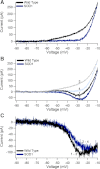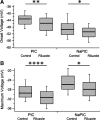Effect of prolonged riluzole exposure on cultured motoneurons in a mouse model of ALS
- PMID: 22013234
- PMCID: PMC3349692
- DOI: 10.1152/jn.00714.2011
Effect of prolonged riluzole exposure on cultured motoneurons in a mouse model of ALS
Abstract
Riluzole is the only FDA-approved drug to treat amyotrophic lateral sclerosis, but its long-term effects on motoneurons are unknown. Therefore, we treated primary mouse spinal cord cultures with 2 μM riluzole for 4-9 days and then used whole cell patch clamp to record the passive and active properties of both wild-type and SOD1(G93A) motoneurons. At this concentration, riluzole blocks >50% of the sodium component of a persistent inward current that plays a major role in determining motoneuron excitability. Prolonged riluzole treatment significantly decreased the amplitude of the persistent inward current. This effect was specific for SOD1(G93A) motoneurons, where the amplitude decreased by 55.4%. In addition, prolonged treatment hyperpolarized the resting membrane potential as well as the voltage onset and voltage maximum of the persistent inward current (∼2-3 mV in each case). These effects appeared to offset one another and resulted in no change in the firing properties. In a subset of cells, acute reapplication of 2 μM riluzole during the recording decreased repetitive firing and the persistent inward current, which is consistent with the normal effects of riluzole. The downregulation of the persistent inward current in response to prolonged riluzole administration is in contrast to the strong upregulation of this same current after descending neuromodulatory drive to the cord is lost following spinal injury. This dichotomy suggests that decreased activation of G protein-coupled pathways can induce upregulation in the persistent inward current but that direct channel block is ineffective.
Figures




Similar articles
-
Mutant SOD1-expressing astrocytes release toxic factors that trigger motoneuron death by inducing hyperexcitability.J Neurophysiol. 2013 Jun;109(11):2803-14. doi: 10.1152/jn.00500.2012. Epub 2013 Mar 13. J Neurophysiol. 2013. PMID: 23486205 Free PMC article.
-
Postnatal electrical and morphological abnormalities in lumbar motoneurons from transgenic mouse models of amyotrophic lateral sclerosis.Arch Ital Biol. 2007 Nov;145(3-4):311-23. Arch Ital Biol. 2007. PMID: 18075124
-
Hyperexcitability in synaptic and firing activities of spinal motoneurons in an adult mouse model of amyotrophic lateral sclerosis.Neuroscience. 2017 Oct 24;362:33-46. doi: 10.1016/j.neuroscience.2017.08.041. Epub 2017 Aug 24. Neuroscience. 2017. PMID: 28844763 Free PMC article.
-
Persistent inward currents in spinal motoneurons: important for normal function but potentially harmful after spinal cord injury and in amyotrophic lateral sclerosis.Clin Neurophysiol. 2010 Oct;121(10):1669-79. doi: 10.1016/j.clinph.2009.12.041. Epub 2010 May 11. Clin Neurophysiol. 2010. PMID: 20462789 Free PMC article. Review.
-
Riluzole: what it does to spinal and brainstem neurons and how it does it.Neuroscientist. 2013 Apr;19(2):137-44. doi: 10.1177/1073858412444932. Epub 2012 May 16. Neuroscientist. 2013. PMID: 22596264 Review.
Cited by
-
Mutant SOD1-expressing astrocytes release toxic factors that trigger motoneuron death by inducing hyperexcitability.J Neurophysiol. 2013 Jun;109(11):2803-14. doi: 10.1152/jn.00500.2012. Epub 2013 Mar 13. J Neurophysiol. 2013. PMID: 23486205 Free PMC article.
-
Astrocytes expressing mutant SOD1 and TDP43 trigger motoneuron death that is mediated via sodium channels and nitroxidative stress.Front Cell Neurosci. 2014 Feb 7;8:24. doi: 10.3389/fncel.2014.00024. eCollection 2014. Front Cell Neurosci. 2014. PMID: 24570655 Free PMC article.
-
Excessive Homeostatic Gain in Spinal Motoneurons in a Mouse Model of Amyotrophic Lateral Sclerosis.Sci Rep. 2020 Jun 3;10(1):9049. doi: 10.1038/s41598-020-65685-8. Sci Rep. 2020. PMID: 32493926 Free PMC article.
-
Selective degeneration of a physiological subtype of spinal motor neuron in mice with SOD1-linked ALS.Proc Natl Acad Sci U S A. 2014 Nov 25;111(47):16883-8. doi: 10.1073/pnas.1419497111. Epub 2014 Nov 10. Proc Natl Acad Sci U S A. 2014. PMID: 25385594 Free PMC article.
-
Riluzole activates TRPC5 channels independently of PLC activity.Br J Pharmacol. 2014 Jan;171(1):158-70. doi: 10.1111/bph.12436. Br J Pharmacol. 2014. PMID: 24117252 Free PMC article.
References
-
- Amendola J, Durand J. Morphological differences between wild-type and transgenic superoxide dismutase 1 lumbar motoneurons in postnatal mice. J Comp Neurol 511: 329–341, 2008 - PubMed
-
- Baker RE, Ruijter JM. Chronic blockade of bioelectric activity in neonatal rat neocortex in vitro: physiological effects. Int J Dev Neurosci 9: 321–329, 1991 - PubMed
-
- Bennett DJ, Hultborn H, Fedirchuk B, Gorassini M. Synaptic activation of plateaus in hindlimb motoneurons of decerebrate cats. J Neurophysiol 80: 2023–2037, 1998 - PubMed
Publication types
MeSH terms
Substances
Grants and funding
LinkOut - more resources
Full Text Sources
Medical
Miscellaneous

